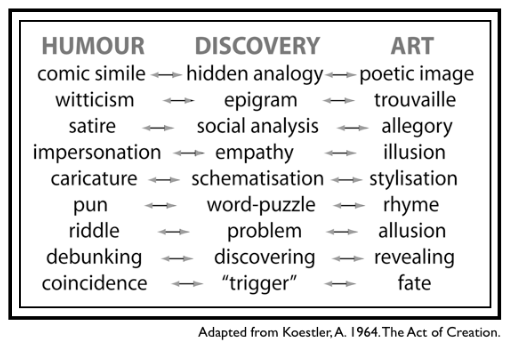The “logic of laughter,” according to Arthur Koestler in 1964’s The Act of Creation, is in “the clash of two mutually incompatible codes, or associative contexts, which explodes the [narrative] tension.”
Here is a joke he attributes to John von Neumann, who like Koestler was Jewish and from Budapest, Hungary. Koestler was born on this date in 1905; von Neumann was two years the elder.
Two women meet while shopping at the supermarket in the Bronx. One looks cheerful, the other depressed. The cheerful one inquires:
‘What’s eating you?’
‘Nothing’s eating me.’
‘Death in the family?’
‘No, God forbid!’
‘Worried about money?’
‘No … nothing like that.’
‘Trouble with the kids?’
‘Well, if you must know, it’s my little Jimmy.’
‘What’s wrong with him, then?’
‘Nothing is wrong. His teacher said he must see a psychiatrist.’
Pause. ‘Well, well, what’s wrong with seeing a psychiatrist?’
‘Nothing is wrong. The psychiatrist said he’s got an Oedipus complex.’
Pause. ‘Well, well, Oedipus or Shmoedipus, I wouldn’t worry so long as he’s a good boy and loves his mamma.’
Here, the “clash” is between the two “codes” of (perceived) scientific knowing and familial identity. There’s a notable parallel in theories of institutional logics, which describe how individuals and organizations create change through the transposition of symbols and practices among institutional orders.
For Koestler, these “bisociative” clashes were the source of creativity — whether in humor, science, or art.
The three panels of the rounded triptych shown on the frontispiece [and adapted above] indicate three domains of creativity which shade into each other without sharp boundaries: Humour, Discovery, and Art. …
Each horizontal line across the triptych stands for a pattern of creative activity which is represented on all three panels. … The logical pattern of the creative process is the same in all three cases; it consists in the discovery of hidden similarities. …
I shall try to show that all patterns of creative activity are tri-valent: they can enter the service of humour, discovery, or art; and also, that as we travel across the triptych from left to right, the emotional climate changes by gradual transitions from aggressive to neutral to sympathetic and identifactory — or, to put it another way, from an absurd through an abstract to a tragic or lyric view of existence.



I’m writing a book about the ways in which we get stuck in life. While thinking about the link between humor and creativity, today, I did a little jog down memory lane to Koestler’s book, The Act of Creation. And, while trying to figure out the source of his triptych, I ran into your interesting site. Which, in turn, reminded me of another old book: Albert Upton’s Design for Thinking. His questions, back in the 70’s, were illuminating: What is this a part of; What is this a sort of; What is this a stage of. I recall generating a different prompt: What is this a pattern of. Which, in turn, takes me full circle, back to your site. Thanks. Chuck
Thanks Chuck. I’m not familiar with Upton’s book, but i will seek it out. Published in 1961 it looks like. “What is this a pattern of?” Indeed!